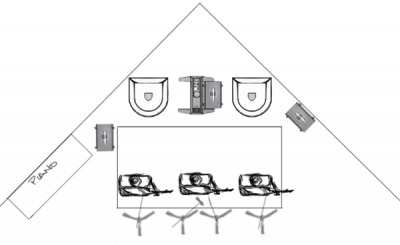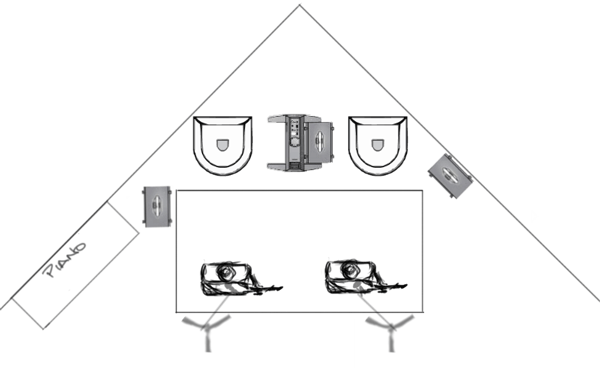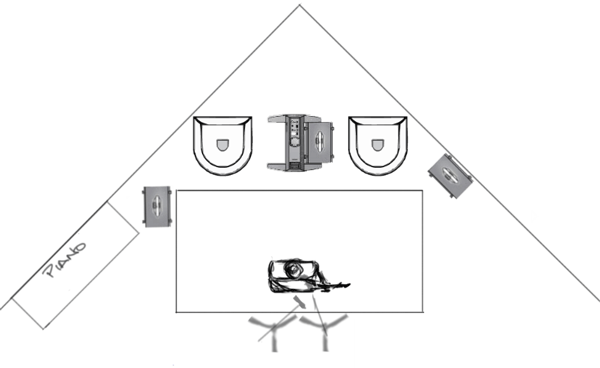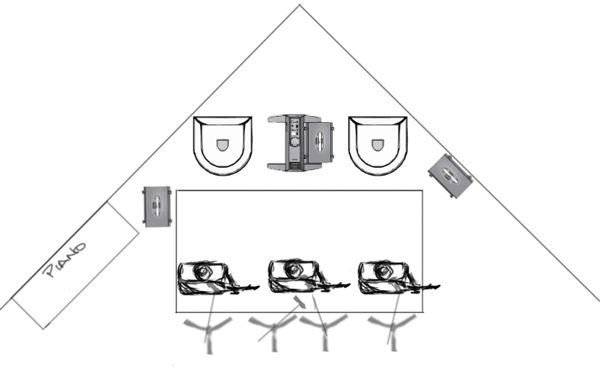Difference between revisions of "Gig Report / House Concert Fundraiser"
m ({{:Stage Layouts / Corner}}) |
m (For another perspective see: Gig Report / House Concert Fundraiser / Audience Perspective written by someone who was in the audience.) |
||
| Line 7: | Line 7: | ||
Original report appears in the {{Forum}} | Original report appears in the {{Forum}} | ||
| − | [http://bose.infopop.cc/eve/forums/a/tpc/f/6806048934/m/3531002905 Gig Report / Fundraiser - House Concert] | + | [http://bose.infopop.cc/eve/forums/a/tpc/f/6806048934/m/3531002905 Gig Report / Fundraiser - House Concert]. For another perspective see: [[Gig Report / House Concert Fundraiser / Audience Perspective]] written by someone who was in the audience. |
December 1, 2007 | December 1, 2007 | ||
Revision as of 06:12, 30 December 2007
|
This article is an editorial and expresses the opinion and experience of the author. Please post comments in the discussion page.
|
|
Original report appears in the Bose® Pro Portable PA Community Gig Report / Fundraiser - House Concert. For another perspective see: Gig Report / House Concert Fundraiser / Audience Perspective written by someone who was in the audience. December 1, 2007 |
At the end of the night — about 3:30am, I was pulling away from the gig and headed into 60 minutes of white-knuckle driving, I was grinning from ear to ear. Even though we had had our first snowfall of the season, a scary event for these parts, we still had about a 75% capacity house and raised about 85% of our very best year ever.
A few highlights
This was a House Concert
Capacity about 150 people not including sound via wireless to a large room in another part of the house.
Backed into a Corner
When I arrived earlier this week to check things out, the stage was set up in the corner and the room was arranged around that. We have done this in other years, but that was for a single performer (Voice and Guitar). I really wanted to get out of that pocket but there was no dissuading the owner. I also had a little of that “Classic” thinking going on and I was imagining trying to get to the back of the L1™ Power Stands to make connections and change Presets. That's tough enough on straight wall, but near impossible in a corner.
Small stage
The stage was 4 x 8 feet, hollow and raised about a foot. There as a thick carpet on top of it. This straddled the corner facing the room diagonally. I managed to pull it out about two feet and put three L1™s behind it. There was a Model II in the middle and a Classic on either side. I was running T1™s on all three. More on this a little later in “The Headliner Arrived Early.”
The Line Up
We had one headliner and four warm-up acts. We were expecting five, but we lost one in the snow. Throughout the evening we flipped the stage six or seven times. No Drums (sorry), this was a Folk, Light Jazz, Acoustic Blues kind of night. Easy changes. The location is a fair hike off the beaten track so there were no on-site rehearsals or sound checks in advance.
The longest turnovers were on either side of a duo where one Guitarist brought his own amp and insisted on using it instead of the “house” system. They arrived late and there was no way to set them up in advance. Besides it was a small stage and I didn't want any back line amps cluttering up the view.
T1™ Scenes
The T1™ Scenes made it easy to switch between settings for the different acts.
The headliner had arrived early, found the T1™, figured it out, and tweaked all the settings before I got there. All I did was suggest some different Presets to try for the microphone on his acoustic Guitar. Then I got as far as telling him about the Scenes, and he created one on his own. More on this a little later in “The Headliner Arrived Early.”
T1™s on stage for the first time
This was the first show for me where I had T1™s on the stage for other performers to use. Although it would have been easy to run the T1™s from offstage, I really wanted to see how the performers would fare with it. It all went very well.
The Stage
When I went down to do the initial set-up, I asked if we could do without the stage altogether. Because it was so small (4 x 8'), low (only 12”) and hollow, I didn't think that it was going to do any more than create an artificial constraint on our working space. The owner was insistent because although the headliner puts on an extremely energetic show waltzing with his Guitar all night, some of the other acts were more sedately seated. He wanted the stage so that the quieter, seated acts would be more visible.
I wasn't particularly happy that the L1™s were a foot lower and behind the stage, so the owner offered to build a platform behind the stage to elevate them. At the time, I declined the offer and set up all the gear. After sleeping on it I called back and asked him to make the platform. He agreed. He was to make the platform and I would get there early on Saturday to tear down and set things up again.
The Headliner Arrived Early
Normally he rolls into town a few hours before the show, we do a quick sound check, and then he relaxes, visits with folks, and then the show begins. This was the first time we were going to have several warm-ups.
Unbeknownst to me, he flew in the night before and stayed at the house. I wish I had known because it would have been nice to head down there and visit. After all, how often can you hang out with someone who has been on the road for nearly forty years? He figures that he's up to around 12,000 shows.
Anyway, I was headed out the door around noon. I like to have a lot of lead time to get there and I was anticipating an hour or two of work at the other end. The snow was already falling and the weather forecast was dire. I phoned ahead to see if there were any last-minute pickups to be made on the way. I found out that our headliner had helped build the platform for the L1™s, torn-down all the gear, put the platform in place, and then set up all the gear again. He has a lot of energy.
By the time I arrived, he had acquainted himself with the T1™, found the Presets, explored the effects. He had basically done everything but save his settings as a Scene. He had also discovered my microphone case and suggested that we try something different for mic'ing the Acoustic Guitar. So we did that, and tweaked a few settings. Then he saved it all as a Scene. Just an aside, he runs his Guitar with a pickup and then likes a microphone on stage with all the low end cut out, and the gain relatively low so that he can lean into it when he wants some more “air” in the sound. We ended up using an AKG C1000s with the hypercardioid insert for this.
Okay – so let's review. Here is a fellow who: with no help from me, tore down my set up, and set it up again, discovered the T1™, figured out how to use it including Presets, Effects, zEQ all within a couple of hours. His prior experience with the L1™ was having played through one a year ago, and once, the year before that. Oh, and somewhere in there he managed to rearrange all the chairs in the room and clear the snow from the patio deck. So any concerns that I might have had about the complexity of the user interface have been allayed.
For the rest of the night as we moved different acts on and off the stage, he was right in there helping people with their settings on the T1™. He wanted to make sure he understood it, and this was his way of doing that.
Later, during his part of the show, he frequently mentioned the great gear -- “It's marvelous, don't you think?”-- and the wonderful job I was doing with the sound. I felt guilty taking credit for any of it.
Except for the snow, it was a great night. One of the acts got stranded on the way, so we had to stretch my set. That was nice because it was an unrehearsed reunion with an old musical collaborator. Good times. We've now got a few more gigs booked in December and January.
After the show was over, I could not dissuade our road-warrior headliner from helping me to tear it all down, pack it up and load it into the car. While we were doing this, other volunteers were cleaning up the debris and putting the house back in order. Somewhere in there we took half hour to just sit back and enjoy our experience with the L1™s, explore the differences between the models, ponder the history of ToneMatch™ Presets, and share raves about the design of the overall System and specifically the T1™.
If you are still with me, thanks for reading. A few things to take from this:
Summary
- T1™ - very, very, very good.
You don't have to invest hours with the manual to use it at a gig, although I would recommend reading the manual at some point.
There is a little more to explain (compared to the R1 Remote) now that we have separate EQ for each channel, but people seemed to understand it very quickly. You can explain volume, mute, channel switching for the Tuner and EQ – all in a couple of minutes.
The Tuner was a big hit.
- T1™ plus Classic is a wonderful working duo.
Most of the night we used the two Classics with T1™s. We used the Model II for our headliner. It just works.
- Avoid the corners. It was very bass-heavy in there; although, it sounded great out front. I find it can be really tough to control feedback on the open strings of my Acoustic Guitar in these situations.
- are great!
That's it for me for now. Thanks for reading, and if you have any questions, fire away.
The discussion continues here: Gig Report / Fundraiser - House Concert
Stage Layouts
|
This article is an editorial and expresses the opinion and experience of ST the author. Please post comments in the discussion page.
|
Stage Layouts
Introduction
This describes a stage layout with four warm up acts (solos and duos) and a headliner (solo) and a finale with the headliner and two others.
Please Note: I would NOT set up in a corner like this again. It sounded great for the audience but on stage it was a little boomy. For the solution see What I should have done.
The room was approximately 50 x 50' with an extension off the opposite corner. So we were playing to people as far away as 85 feet at the far end.
This is pretty close to scale for the distances, so the performers were about 3-4 feet in front of the L1™s. Not a lot of room given the 2500+ square feet we were trying to fill.
T1 ToneMatch® Audio Engine
I ran T1™s mounted on each the microphone stands controlling the L1™ directly behind it. I had a Scene worked out specifically for the headliner for the night. He was the only person who had been available for a sound check. I knew roughly what the other performers were going to be using for instruments so I made up generic Scenes for them. For example,
- Vocal plus Acoustic Guitar with Piezo pickup.
- Vocal plus Taylor Dreadnought Strum Style
- Vocal plus Taylor Dreadnought Finger Style
This made it very simple to have people walk up, turn the dial to the appropriate Scene, explain how to use the volume dial and mute buttons, and that was it!
I had set the gain staging and volumes so that nothing was feeding back even when the stage was empty so things went pretty smoothly from that point.
Warm Up Acts
Here is how things looked for the warm up acts that were duos.
I was on the left side as you view this, and found it very bass heavy for my acoustic Guitar. My partner on the other side said it was a little boomy but not too bad. We both had the zEQ settings with the bass at -6.0 db or so. I had the ParaEQ at -12db at 50 Hz with the width at .5.
I play finger style, no picks - so when I dig in, especially for soloing, I get a bit of finger "thump". The parametric EQ really helps with that.
My partner for the night plays mainly with a pick so he doesn't have that issue.
Headliner - Solo
Here is how our headliner looked on stage. He ran through the Model II.
It felt a little bottom heavy but not nearly as much as it did in the duo setup.
We have done other shows where it was just him, with no warm-up acts. We used a single L1™ Classic in the same position as the L1™ above. Things sounded fine.
Minor note: We pulled the other microphone stands off to the sides during this part of the show.
Not shown: There was a T1™ on the microphone stand on the right. Inputs were:
- - Vocal microphone
- - Guitar - internal pickup
- - AKG C1000s just for 'air'
He was all over the stage. He literally dances his way through his set most often like a graceful waltz. When he was 'on the mic' he was really 'on the mic' (close microphone technique). The same was true for the AKG microphone on his Guitar. He used it like an effect. Not all the time, but when there was a particular sound he wanted.
And I know you want to know... there was one little squeal at the beginning of the show as he stepped off the stage to hit the switch for the lights. We reoriented the Guitar microphone so it was aimed as you see it in the sketch above. No issues with feedback for the rest of the night.
Finale
Toward the end of the last set our headliner called the owner and me up to the stage. We thought he was going to acknowledge the cause (Cancer research) and the house (the owner's purpose built room for musical performances) and he did. He also mentioned the wonderful sound system and thanked me yet again for doing the sound. But then he surprised us.
It took about 60 seconds to pull the other microphone stands (with T1™s mounted on them) back into the stage area.
Here is how we ended the night.
What I should have done
I have should have moved the B1s. Time permitting, a little experimentation would have been good, but this would probably have been better.








